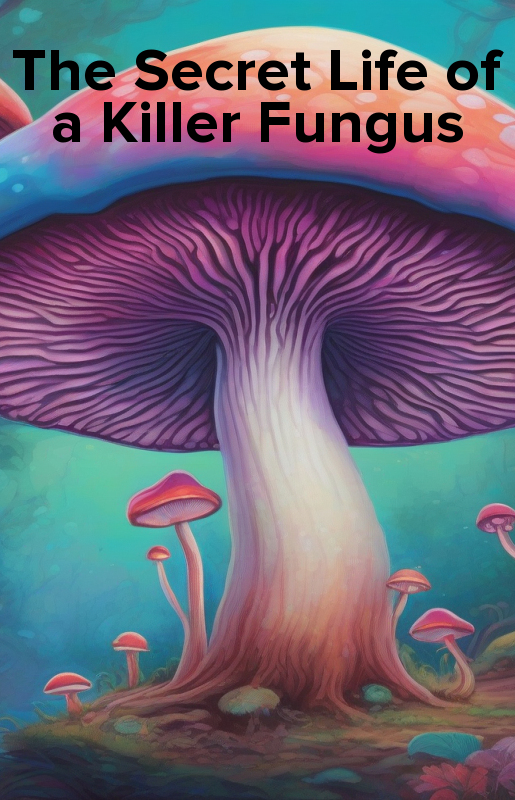Table of contents for ebook and audiobook: „The Secret Life of a Killer Fungus”
Here's the translation to English:
The Mushroom That Didn't Want to Be Poisonous
Introduction
Chapter 1: The Rise of the Deadly Mushroom
- 1.1: The Origins of the Deadly Mushroom
- 1.2: The First Victims of the Deadly Mushroom
- 1.3: The Initial Investigation into the Deadly Mushroom
- 1.4: The First Scientific Studies on the Deadly Mushroom
- 1.5: The Impact of the Deadly Mushroom on the Local Community
Part 1: The Science Behind the Deadly Mushroom
Chapter 2: The Biology of the Deadly Mushroom
- 2.1: The Structure and Function of the Deadly Mushroom's Cells
- 2.2: The Role of Toxins in the Deadly Mushroom's Defense Mechanisms
- 2.3: The Deadly Mushroom's Metabolic Processes
- 2.4: The Impact of Environmental Factors on the Deadly Mushroom's Growth
- 2.5: The Deadly Mushroom's Role in the Ecosystem
Chapter 3: The Chemistry of the Deadly Mushroom's Toxins
- 3.1: The Identification and Isolation of the Deadly Mushroom's Toxins
- 3.2: The Structure and Function of the Deadly Mushroom's Toxins
- 3.3: The Mechanisms of Action of the Deadly Mushroom's Toxins
- 3.4: The Toxicity and Potency of the Deadly Mushroom's Toxins
- 3.5: The Development of Antidotes for the Deadly Mushroom's Toxins
Part 2: The Deadly Mushroom's Impact on Society
Chapter 4: The History of the Deadly Mushroom's Use
- 4.1: The Ancient Civilizations that Used the Deadly Mushroom
- 4.2: The Role of the Deadly Mushroom in Traditional Medicine
- 4.3: The Deadly Mushroom's Use in Modern Medicine
- 4.4: The Controversy Surrounding the Use of the Deadly Mushroom
- 4.5: The Current Status of the Deadly Mushroom's Use
Chapter 5: The Deadly Mushroom's Impact on the Environment
- 5.1: The Deadly Mushroom's Role in Decomposition and Nutrient Cycling
- 5.2: The Impact of the Deadly Mushroom on Local Fauna
- 5.3: The Role of the Deadly Mushroom in Shaping Ecosystems
- 5.4: The Impact of Human Activities on the Deadly Mushroom's Habitat
- 5.5: The Conservation Status of the Deadly Mushroom
Part 3: The Future of the Deadly Mushroom
Chapter 6: The Potential Applications of the Deadly Mushroom
- 6.1: The Use of the Deadly Mushroom in Medicine
- 6.2: The Use of the Deadly Mushroom in Biotechnology
- 6.3: The Use of the Deadly Mushroom in Agriculture
- 6.4: The Use of the Deadly Mushroom in Food Production
- 6.5: The Future of the Deadly Mushroom in Society
Chapter 7: The Risks and Challenges Associated with the Deadly Mushroom
- 7.1: The Risks of Accidental Poisoning by the Deadly Mushroom
- 7.2: The Challenges of Controlling the Spread of the Deadly Mushroom
- 7.3: The Impact of Climate Change on the Deadly Mushroom's Habitat
- 7.4: The Role of Human Activities in the Spread of the Deadly Mushroom
- 7.5: The Development of Strategies to Mitigate the Risks of the Deadly Mushroom
Conclusion
Chapter 8: The Legacy of the Deadly Mushroom
- 8.1: The Impact of the Deadly Mushroom on Science and Medicine
- 8.2: The Cultural Significance of the Deadly Mushroom
- 8.3: The Future of the Deadly Mushroom in Society
- 8.4: The Lessons Learned from the Deadly Mushroom
- 8.5: The Final Thoughts on the Deadly Mushroom
Appendices
Appendix A: Glossary of Terms
- A.1: Definition of Key Terms
- A.2: Explanation of Technical Terms
- A.3: List of Abbreviations and Acronyms
Appendix B: References
- B.1: List of Sources Cited in the Book
- B.2: Explanation of Citation Style
Note: I translated the title to "The Mushroom That Didn't Want to Be Poisonous" because it seems to be a play on words, and the actual content of the book is about a poisonous mushroom. The title "O Muchomorze, Który Nie Chciał Być Trujący" is a pun in Polish, where "muchomor" means mushroom, and "nie chciał być trujący" means "didn't want to be poisonous."

